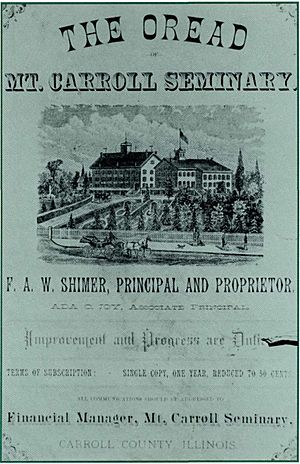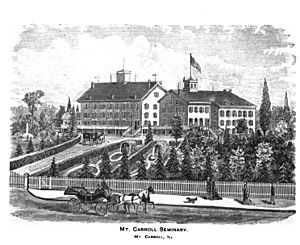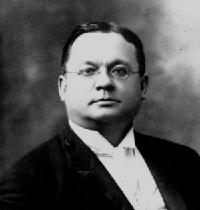Mount Carroll Seminary facts for kids
The Mount Carroll Seminary was the first name of Shimer College from 1853 to 1896. It was located in Mount Carroll, Illinois, in the United States. This school was a very important place for learning and culture in northwestern Illinois during the 1800s. Even though many people thought it would fail, it grew from just 11 students in one room to more than 100 students on a large campus. What was special about it was that it was run entirely by women. The most important person was the founder, Frances Wood Shimer, who was in charge for its whole existence.
Contents
- Starting the School: Mount Carroll Seminary's Beginnings
- How the School Was Run: Women in Charge
- Important People: Leaders and Learners
- What Students Learned: Academics at the Seminary
- Getting In and Paying for School: Admissions and Financial Help
- Life as a Student: Daily Routines and Activities
- The School Campus: Buildings and Grounds
- Becoming the Frances Shimer Academy: A New Chapter
Starting the School: Mount Carroll Seminary's Beginnings
The Mount Carroll Seminary started before there were any public schools in Mount Carroll. Many people at the time didn't think education was very important. In the 1850s, more schools for women were opening, especially in the Midwest. But in western Illinois, it was still very unusual to have a school for women's higher education.
Many people were against the idea of women getting a higher education. Also, it was rare for women to run a successful business, which caused some problems in the local community. From the very beginning, many people predicted that the seminary would not last.
The official permission to start the Mount Carroll Seminary came from the Illinois General Assembly on June 18, 1852. Judge John Wilson, who strongly believed in education, helped create this document.
To open the school, teachers were needed. Judge Wilson contacted Isaac Nash, a wealthy farmer in New York. Living in Nash's house were Frances Wood (who later became Frances Shimer) and Cindarella Gregory. They had just graduated from the New York State Normal School. Frances Wood was looking for a change of climate because she was sick. Both women agreed to be the first teachers at the new seminary.
Classes began on May 11, 1853, in a single room at the Presbyterian church with 11 students. More students joined that year, and the school moved to a bigger temporary spot. When the school opened in its own building in October 1854, there were 75 students.
The school needed a permanent home. People bought shares for $5 each to help fund it. Less than half of the money promised was actually collected. Five acres of land were bought for $500, even though the land was usually much cheaper. The price went up when people found out a school would be built there. The main building cost $4,500, mostly paid for later. Furniture cost another $2,000. All these debts made the founders very worried.
How the School Was Run: Women in Charge
The school was officially organized in October 1854. At first, a Board of Trustees, made up of nine founders, ran the school. But this arrangement did not last long.
In 1855, the founders worried the school would fail because they hadn't collected enough money. So, they sold their shares to the teachers, Frances Wood and Cindarella Gregory. This was a good deal for the teachers. The land was given to them, and the buildings were sold at their original cost. The only condition was that Wood and Gregory had to keep the school running for at least 10 years. This change happened on March 30, 1855.
From 1853 to 1896, Frances Shimer was the main leader of the school. She was called "Principal," but she is seen as the first president of Shimer College. At first, she worked with Cindarella Gregory. Frances handled the money, and Cindarella was in charge of the school's lessons. In July 1870, Cindarella Gregory left the school. After that, Frances Wood Shimer owned the Mount Carroll Seminary by herself until she retired in 1896.
People believed that Frances Shimer's careful management saved the school. She was very strict about saving money, which kept the school financially stable. For most of her time in charge, the school did not try to find new students or ask for donations. Instead, it focused on being a school that people could trust.
Important People: Leaders and Learners
School Leaders and Teachers
- Principal Frances Shimer was the co-owner with Cinderella Gregory until 1870. After that, she was the sole owner until 1896. She also taught in the early years. As she became busier with running the school, others took over teaching. She was very involved in the "Labor Department" and oversaw all new buildings and planting on campus.
- Principal Cinderella Gregory was co-owner with Frances Shimer. She left the Seminary in 1870 and sold her shares to Frances Shimer.
- Associate Principal Adelia C. Joy joined the Seminary in 1870. She took Cinderella Gregory's place as the main person in charge of academics. As Frances Shimer got older, Adelia Joy also became more involved in the school's money matters.
- Henry Shimer, a doctor and naturalist, taught natural sciences at the Seminary after 1866. He married Frances Shimer on December 22, 1857.
- Isabel Dearborn Hazzen was the director of the music program. She was known for being a great music teacher. She started working at the seminary in the late 1860s.
Famous Students
- Alice Ives Breed graduated in 1871. She became a social leader and clubwoman.
- Gertrude Brown Murrah graduated in 1885. She later started the Creal Springs Seminary, which was a college and music school. It closed in 1916.
- Samuel W. McCall, who became the governor of Massachusetts, studied at the Seminary from 1864 to 1866. He had to leave because the school stopped accepting male students.
What Students Learned: Academics at the Seminary
In 1860, the school set up a formal plan for what students would learn. The Mount Carroll Seminary worked like a preparatory school. It had a six-year program that helped students get ready for more advanced studies. Some graduates were so well prepared that they could skip the first years of college. Students learned subjects like math, science, and classical languages.
In the early 1870s, the school started offering special courses taught by expert teachers. These special departments included a normal department for training schoolteachers and a music department. In 1882, graduates came from the normal program, the college program, the music program, and the art program.
The normal department trained students to become schoolteachers. This was seen as one of the few good jobs for women outside the home. Many schools wanted teachers trained by the Seminary. At the end of each term, many students found teaching jobs right away, even without officially graduating. In 1877, 30 students from the previous term found teaching positions.
The music and arts programs were a big reason why students came to the seminary. The seminary had the first piano in Carroll County. The music program started with only 3 students but grew quickly. By 1877, the music department had 6 teachers. By 1883, the music school had almost 40 instruments. Isabel Dearborn Hazzen, a voice teacher, led the music program during this time. The music and arts programs stayed strong even after the seminary became the Frances Shimer Academy in 1896. By the 1870s, there was also a literary department.
In 1878, a department for telegraphy was started. This gave students another career choice besides teaching.
Getting In and Paying for School: Admissions and Financial Help
The seminary accepted any student who wanted to learn. It even welcomed very young children. Frances Shimer herself started school at two and a half years old. During and after the US Civil War, more girls enrolled, while fewer boys did.
Because there wasn't enough space, the school, which used to accept both boys and girls, limited living on campus to women in 1866. Some boys were still allowed to attend classes during the day. Even though the school planned to accept male students again, it remained a school for women throughout the seminary period. It did not become coeducational again until 1950.
Financial help was available, including a program like today's work study. The school had a "Labor Department" where students could work to pay for their tuition. Some male students were also accepted for these jobs and had special places to stay.
Scholarships were also given to certain groups of students. For example, one teacher from each township in Carroll County could get a full scholarship to the normal department. The same was true for one teacher from each county in the state. Daughters of soldiers who died in the Civil War also received full scholarships. Daughters of religious leaders received partial scholarships. Sometimes, scholarships were given to the children of people the school owed money to.
Financial help also came in the form of loans. Students with good grades could pay part of their tuition with notes that did not charge interest for a year.
The number of students grew steadily through the 1800s, limited mostly by how much space was available. In the 1870s, there were about 125 students each year.
Life as a Student: Daily Routines and Activities
Student life at the Seminary involved long days, from 8 AM until lights out at 9:30 PM. Life was also structured by strict rules. For example, students could not leave the school without a request from home. They also could not have visitors unless their parents approved. Many students lived at the school, but a good number were day-students who lived with their families nearby. When the seminary officially opened in 1854, about two-thirds of the students were day-students. As the school's reputation grew, more students came from farther away.
The Seminary had several student groups. One of the first was the Neosophic Society. Later, under the Shimer-Joy leadership from 1870, campus groups included a Reunion Club (for former students), a German Club, a Missionary Club, a Literary Society, and the Oread Society.
The first student publication was the Seminary Bell. It was an eight-page monthly newspaper started by the Neosophic Society in 1859. This paper was published for a while from the offices of the Carroll County Republican. The Bell stopped being published in 1862.
In 1869, the Oread Society started publishing the Oread, also a monthly newspaper. The Oread also included announcements and advertisements from the school. In 1869, it was 16 pages long, and by 1878, it had grown to 25 pages.
The School Campus: Buildings and Grounds
Throughout the 1800s, the campus steadily grew from just one building. By 1878, four buildings had been built. The first three were connected, making them look like one big building. Inside, the buildings were designed to feel like a home, with many small rooms.
The first brick building, built in 1854, was initially two and a half stories tall. It had 20 rooms. Later, it was made taller, to four stories. By 1878, the entire first floor, which used to have seven rooms, was opened up to create one large dining room for everyone. The second floor had the library, office, reception room, and music room. The library was started in 1867 and held 3,000 books by 1878. The third and fourth floors had private rooms and trunk rooms.
The second and third buildings were built in 1857 and from 1865 to 1867. The second building was two and a half stories tall and was added to the southeast of the first building. Building this addition in 1857 stopped because of a money crisis. Only the brickwork and carpentry were finished. Frances Wood, Cindarella Gregory, and their students worked together to finish the building in time for classes to start. They saved money this way, and they did the same for the expansion from 1865 to 1867.
Frances Wood Shimer drew the plans for both of these buildings. In 1878, these two buildings were four stories tall. They had classrooms on the first floor, as well as four private rooms for young men who worked in the Labor Department. The second and third floors had dormitory rooms, and the fourth floor was for art studios and music practice rooms.
The fourth building, finished in 1876, was five stories tall. It was called the "East Hall." The first floor had utility rooms like the kitchen, furnace room, and laundry. The second floor had music rooms on one side and the principal's rooms and a sick room on the other. The third and fourth floors had student dorm rooms. The fifth floor included a sunbathing room, more music practice rooms, and large tanks for holding water.
The campus grounds started in 1854 with 5 acres of empty land that had been a wheat field. By 1883, the campus covered 25 acres. Much of it was planted with fruit trees. The landscaping was designed to create beautiful and natural-looking scenes, like an ideal countryside. The orchards and vineyards on the grounds were used for both practical reasons and fun. Their products were not sold but were used entirely to feed the "Seminary family."
Besides the main buildings, there were many smaller buildings. One was the windmill house, which was octagonal (eight-sided) and near the main building. It drew water from a well 130 feet deep. Maps from 1894 also show icehouses, henhouses, and corn cribs.
Becoming the Frances Shimer Academy: A New Chapter
In the 1880s, Frances Shimer worried about the school's future. She tried many times to get money donated to the school. In 1886, she offered the seminary to the Woman's Christian Temperance Union if they could raise enough money. She made a similar offer to Baptist women in Illinois in 1887, asking for $100,000. But the money was never raised.
Frances Shimer's own efforts to provide money for the school also faced problems. Her husband, Henry Shimer, left all his money to Frances to use for education when he died in 1895. However, his family challenged the will, and the amount of money she received was much less. Frances Shimer also expected money from her orange groves in Florida, but a bad frost in 1895 destroyed them.
On July 1, 1896, Frances Shimer gave control of the seminary to a 15-member board of trustees. This was part of a new connection with the University of Chicago. At that time, the school was worth about $250,000. This connection was mainly about educational standards and did not include any financial help.
After this, the school became known as the Frances Shimer Academy of the University of Chicago. The school also adopted the University of Chicago's connection with the Baptist church. This meant that at least two-thirds of the Board members had to be part of a Baptist church. The Board members were equally divided among representatives from the University of Chicago, graduates of the Mount Carroll Seminary, and people from Mount Carroll.








